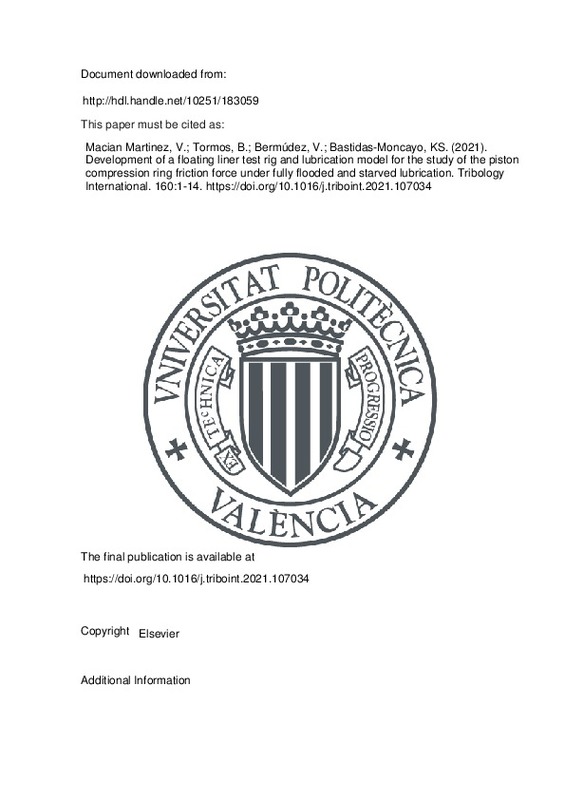JavaScript is disabled for your browser. Some features of this site may not work without it.
Buscar en RiuNet
Listar
Mi cuenta
Estadísticas
Ayuda RiuNet
Admin. UPV
Development of a floating liner test rig and lubrication model for the study of the piston compression ring friction force under fully flooded and starved lubrication
Mostrar el registro sencillo del ítem
Ficheros en el ítem
| dc.contributor.author | Macian Martinez, Vicente
|
es_ES |
| dc.contributor.author | Tormos, B.
|
es_ES |
| dc.contributor.author | Bermúdez, Vicente
|
es_ES |
| dc.contributor.author | Bastidas-Moncayo, Kared Sophia
|
es_ES |
| dc.date.accessioned | 2022-06-02T18:02:26Z | |
| dc.date.available | 2022-06-02T18:02:26Z | |
| dc.date.issued | 2021-08 | es_ES |
| dc.identifier.issn | 0301-679X | es_ES |
| dc.identifier.uri | http://hdl.handle.net/10251/183059 | |
| dc.description.abstract | [EN] Advances in internal combustion engines make it necessary to study in depth their contribution to engine efficiency, and thus to friction mechanical losses, especially those generated in the piston-cylinder liner assembly. In this paper, the design of a novel test rig is presented, based on the floating liner principle, with the key objective of having the capability of developing multiple parameters tests in a relatively quick and easy way. The final design integrates a single-cylinder internal combustion engine, a mechanical solution that allows the liner to float, three piezoelectric force sensors and a novel design of lateral support based on ball transfer units. Reproducibility and repeatability of tests were assessed demonstrating the capability of the test rig to develop reliable friction measurements. Some parameters tests were developed to evaluate the sensitivity of the friction force measurements to variations in the working conditions, oil temperature and engine speed. A theoretical model for the piston compression ring is presented for both fully flooded and starved lubrication conditions, including asperity interactions and lubricant rheology. Comparisons of these approaches with experimental results showed that, for the working conditions of the test rig, lubrication of the compression ring is better estimated under fully flooded lubrication condition, as the starved lubrication analysis results in over-estimated friction force values at higher engine speed regimes. | es_ES |
| dc.description.sponsorship | Author Sophia Bastidas would like to thank to the support of the program Ayudas de Investigacion y Desarrollo (PAID-01-17) of the Universitat Politecnica de Valencia, Spain | es_ES |
| dc.language | Inglés | es_ES |
| dc.publisher | Elsevier | es_ES |
| dc.relation.ispartof | Tribology International | es_ES |
| dc.rights | Reconocimiento - No comercial - Sin obra derivada (by-nc-nd) | es_ES |
| dc.subject | Floating liner | es_ES |
| dc.subject | Friction force measurement | es_ES |
| dc.subject | Numerical model | es_ES |
| dc.subject | Parameters tests | es_ES |
| dc.subject | Lubricant oil | es_ES |
| dc.subject.classification | MAQUINAS Y MOTORES TERMICOS | es_ES |
| dc.title | Development of a floating liner test rig and lubrication model for the study of the piston compression ring friction force under fully flooded and starved lubrication | es_ES |
| dc.type | Artículo | es_ES |
| dc.identifier.doi | 10.1016/j.triboint.2021.107034 | es_ES |
| dc.relation.projectID | info:eu-repo/grantAgreement/UPV//PAID-01-17//Contratos Pre-Doctorales UPV 2017- Subprograma 1/ | es_ES |
| dc.rights.accessRights | Abierto | es_ES |
| dc.contributor.affiliation | Universitat Politècnica de València. Departamento de Máquinas y Motores Térmicos - Departament de Màquines i Motors Tèrmics | es_ES |
| dc.description.bibliographicCitation | Macian Martinez, V.; Tormos, B.; Bermúdez, V.; Bastidas-Moncayo, KS. (2021). Development of a floating liner test rig and lubrication model for the study of the piston compression ring friction force under fully flooded and starved lubrication. Tribology International. 160:1-14. https://doi.org/10.1016/j.triboint.2021.107034 | es_ES |
| dc.description.accrualMethod | S | es_ES |
| dc.relation.publisherversion | https://doi.org/10.1016/j.triboint.2021.107034 | es_ES |
| dc.description.upvformatpinicio | 1 | es_ES |
| dc.description.upvformatpfin | 14 | es_ES |
| dc.type.version | info:eu-repo/semantics/publishedVersion | es_ES |
| dc.description.volume | 160 | es_ES |
| dc.relation.pasarela | S\434231 | es_ES |
| dc.contributor.funder | Universitat Politècnica de València | es_ES |







![[Cerrado]](/themes/UPV/images/candado.png)

